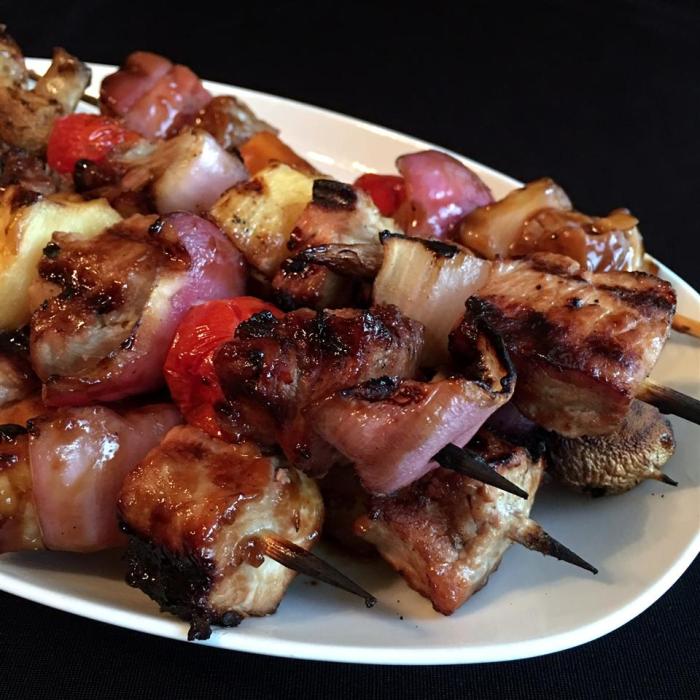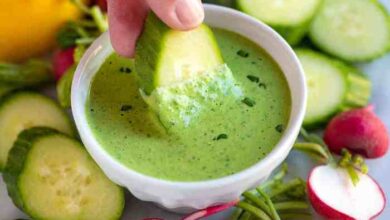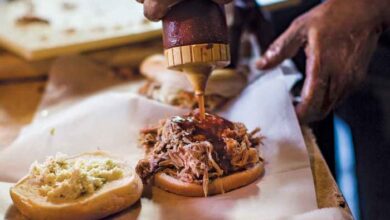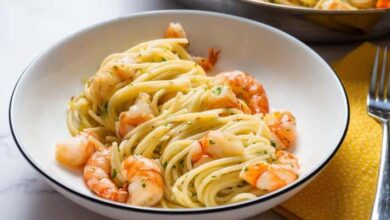
BBQ Teriyaki Pork Kabobs: A Flavorful Fusion
BBQ Teriyaki Pork Kabobs are a delicious and versatile dish that blends the smoky flavors of barbecue with the sweet and savory notes of teriyaki sauce. This culinary masterpiece has roots in both American barbecue traditions and Japanese teriyaki techniques, resulting in a truly unique and satisfying taste experience.
The appeal of BBQ Teriyaki Pork Kabobs lies in their ability to satisfy a wide range of palates. The combination of tender pork, vibrant vegetables, and a flavorful marinade creates a dish that is both visually appealing and incredibly tasty.
Whether you’re grilling on a warm summer evening or seeking a comforting meal during the colder months, these kabobs offer a delightful and satisfying culinary adventure.
BBQ Teriyaki Pork Kabobs
BBQ Teriyaki Pork Kabobs are a delightful fusion of American and Japanese culinary traditions, offering a flavorful and satisfying dish that’s perfect for grilling or broiling. The succulent pork is marinated in a sweet and savory teriyaki sauce, then skewered and cooked to juicy perfection.
Origins and History
The origins of BBQ Teriyaki Pork Kabobs can be traced back to the confluence of two distinct culinary traditions: American barbecue and Japanese teriyaki. American barbecue, with its emphasis on slow-cooked meats and smoky flavors, has been a cornerstone of American cuisine since the 18th century.
Japanese teriyaki, on the other hand, emerged in the 17th century, characterized by its use of soy sauce, mirin, and sugar to create a sweet and savory glaze.
Appeal of BBQ Teriyaki Pork Kabobs
The appeal of BBQ Teriyaki Pork Kabobs lies in their unique blend of flavors and textures. The pork, marinated in teriyaki sauce, develops a rich, caramelized exterior while remaining tender and juicy inside. The smoky notes from grilling or broiling add another layer of complexity to the flavor profile.
Moreover, the kabob format allows for easy portioning and versatility, making it a popular choice for both casual and formal gatherings.
Ingredients and Preparation
Preparing BBQ Teriyaki Pork Kabobs involves selecting quality ingredients and mastering the art of marinating and grilling. This recipe is a delicious fusion of sweet and savory flavors, where the tender pork is infused with the tangy teriyaki sauce. Let’s delve into the details of the ingredients and preparation process.
BBQ teriyaki pork kabobs are a classic summer grilling staple, and while they’re delicious on their own, adding a vibrant salsa can really elevate the dish. I love pairing them with a mango peach and pineapple salsa , the sweetness of the fruit complements the savory pork perfectly, and the salsa’s fresh acidity cuts through the richness of the teriyaki glaze.
Ingredients
The essential ingredients for BBQ Teriyaki Pork Kabobs include:
- Pork:Choose boneless, skinless pork tenderloin or pork loin. These cuts are lean and tender, making them ideal for kabobs.
- Vegetables:Popular choices include bell peppers (red, yellow, green), onions, zucchini, and pineapple. Select firm, fresh vegetables for grilling.
- Teriyaki Sauce:You can use a store-bought teriyaki sauce or prepare your own. A good teriyaki sauce typically contains soy sauce, mirin (sweet rice wine), sugar, and ginger.
- Marinade:The marinade for the pork can be as simple as teriyaki sauce or a blend of teriyaki sauce with other ingredients like garlic, sesame oil, and honey.
- Skewers:Use metal or wooden skewers. Soak wooden skewers in water for at least 30 minutes before using to prevent them from burning.
Marinating the Pork
Marinating the pork is crucial for infusing it with flavor and keeping it tender. Here’s how:
- Cut the pork:Cut the pork tenderloin or loin into 1-inch cubes.
- Prepare the marinade:Combine the teriyaki sauce with your desired additional ingredients in a bowl. You can experiment with different flavor profiles by adding ingredients like garlic, ginger, sesame oil, or honey.
- Marinate the pork:Place the pork cubes in a resealable bag or a shallow dish and pour the marinade over them. Ensure all the pork pieces are coated in the marinade. Refrigerate for at least 2 hours, or preferably overnight, for optimal flavor infusion.
Preparing the Vegetables
The vegetables should be cut into bite-sized pieces for easy grilling.
- Wash and cut the vegetables:Wash the vegetables thoroughly and cut them into 1-inch pieces. For bell peppers, remove the seeds and core before cutting.
- Consider grilling time:Cut the vegetables into similar sizes to ensure even cooking. If you are using vegetables that require different cooking times, such as zucchini and pineapple, you can pre-cook them slightly before skewering.
Assembling the Kabobs
Once the pork and vegetables are ready, you can assemble the kabobs.
- Alternating ingredients:Thread the pork and vegetables onto the skewers, alternating them for visual appeal and balanced flavors. For example, you could alternate a piece of pork, a bell pepper, an onion, and a pineapple chunk.
- Leave space:Leave a little space between each ingredient on the skewer to allow for even cooking.
Grilling the Kabobs
Grilling is the most popular method for cooking BBQ Teriyaki Pork Kabobs.
- Preheat the grill:Preheat your gas or charcoal grill to medium-high heat (about 400-450°F).
- Grill the kabobs:Place the kabobs on the preheated grill and cook for about 5-7 minutes per side, or until the pork is cooked through and the vegetables are tender.
“Use a meat thermometer to ensure the pork is cooked to an internal temperature of 145°F.”
- Basting:While grilling, baste the kabobs with the remaining marinade or a teriyaki glaze for added flavor and shine.
Baking the Kabobs
If you don’t have a grill, you can bake the kabobs in the oven.
- Preheat the oven:Preheat your oven to 400°F.
- Place the kabobs on a baking sheet:Line a baking sheet with parchment paper and place the kabobs on it. Ensure the kabobs are not touching each other.
- Bake the kabobs:Bake for 15-20 minutes, or until the pork is cooked through and the vegetables are tender.
“Baste the kabobs with the marinade or glaze halfway through baking for added flavor.”
Flavor Profile: Bbq Teriyaki Pork Kabobs
BBQ Teriyaki Pork Kabobs boast a harmonious blend of sweet, savory, and smoky flavors, making them an irresistible culinary delight. The interplay of these flavor profiles creates a truly unique taste experience.
Dominant Flavors and Their Interplay
The dominant flavors in BBQ Teriyaki Pork Kabobs are sweet, savory, and smoky. The sweetness comes from the teriyaki sauce, which is typically made with soy sauce, sugar, and mirin. The savory flavor comes from the pork and the soy sauce in the marinade.
The smoky flavor comes from the grilling process.The interplay of these flavors is what makes BBQ Teriyaki Pork Kabobs so delicious. The sweetness of the teriyaki sauce balances out the savory flavor of the pork. The smoky flavor adds depth and complexity to the dish.
BBQ teriyaki pork kabobs are a delicious and easy weeknight meal, but sometimes I crave something sweet and creamy to finish off the meal. That’s when I turn to maja blanca coconut pudding , a Filipino dessert that’s light and refreshing.
The creamy coconut milk and sweet condensed milk create a heavenly combination that perfectly complements the savory flavors of the pork kabobs.
The Role of Marinade and Glaze
The marinade and glaze play a crucial role in creating the unique flavor profile of BBQ Teriyaki Pork Kabobs. The marinade tenderizes the pork and infuses it with flavor. The glaze adds a final layer of sweetness and shine to the kabobs.
The marinade typically consists of soy sauce, sugar, mirin, garlic, and ginger. The glaze is often a variation of the marinade, with the addition of cornstarch or arrowroot powder to thicken it.
Balance of Sweet, Savory, and Smoky Flavors
The ideal balance of sweet, savory, and smoky flavors in BBQ Teriyaki Pork Kabobs is subjective. However, a well-balanced kabob will have a noticeable sweetness from the teriyaki sauce, a savory flavor from the pork and soy sauce, and a subtle smokiness from the grilling process.The balance of these flavors can be adjusted by adjusting the amount of sugar in the marinade and glaze.
For example, if you prefer a sweeter kabob, you can add more sugar to the marinade and glaze. If you prefer a more savory kabob, you can reduce the amount of sugar.
Serving Suggestions
These BBQ Teriyaki Pork Kabobs are incredibly versatile and can be enjoyed in various ways. To complement the savory and sweet flavors of the kabobs, consider pairing them with a variety of side dishes and condiments.
BBQ teriyaki pork kabobs are a classic summer grilling staple, but I love adding a little extra zing to my skewers. I always pair them with a side of pickled jalapenos and carrots , which adds a nice contrast of sweet, spicy, and tangy flavors.
The combination is truly irresistible and always gets rave reviews from my guests!
Side Dishes
Pairing these kabobs with the right side dishes can enhance the overall dining experience. Here are some suggestions:
- Rice:White rice, brown rice, or even fried rice are excellent choices to soak up the delicious teriyaki sauce.
- Noodles:Thinly sliced ramen noodles or udon noodles can add a different texture and complement the savory flavors.
- Vegetables:Grilled or steamed vegetables like asparagus, broccoli, bell peppers, or zucchini provide a refreshing contrast to the richness of the pork.
- Salads:A simple green salad with a light vinaigrette can help balance the meal.
- Fruit Salad:A refreshing fruit salad with pineapple, mango, or strawberries adds a touch of sweetness and acidity.
Sauces and Condiments
Enhancing the flavors of these kabobs can be achieved by adding a variety of sauces and condiments. Here are some options:
- Extra Teriyaki Sauce:For those who prefer a more intense teriyaki flavor, additional sauce can be drizzled over the kabobs.
- Sriracha Sauce:A dash of sriracha adds a touch of heat and complexity to the flavor profile.
- Wasabi Mayo:A creamy and spicy wasabi mayo dip provides a unique and flavorful accompaniment.
- Sesame Seeds:Toasted sesame seeds sprinkled on top add a nutty flavor and a pleasing crunch.
Plating Options
The presentation of these kabobs can elevate the dining experience. Consider these creative plating options:
- Skewer Arrangement:Arrange the kabobs in a visually appealing pattern on a platter, alternating the colors of the vegetables and pork.
- Serving Bowls:Serve the kabobs in individual bowls with a side of rice, noodles, or salad. This allows for a more intimate and personal presentation.
- Garnish:Garnish the plate with fresh herbs like cilantro or parsley, or a sprinkle of sesame seeds for an added touch of elegance.
Serving Temperature
The ideal temperature for serving these BBQ Teriyaki Pork Kabobs is hot. This ensures the pork is cooked through and the teriyaki sauce is warm and flavorful. The kabobs can be served immediately after grilling or reheated in the oven or on the stovetop.
Variations and Adaptations

These BBQ teriyaki pork kabobs are incredibly versatile and can be easily adapted to suit your preferences and dietary needs. Let’s explore some exciting variations and modifications that will elevate your kabob game!
Alternative Recipes for BBQ Teriyaki Pork Kabobs
This recipe is a great starting point for creating unique variations. Here are a few ideas to get you started:
- Honey Garlic Pork Kabobs:Substitute the teriyaki sauce with a honey garlic marinade. Combine honey, soy sauce, garlic, ginger, and a touch of sesame oil for a sweet and savory flavor profile.
- Spicy Teriyaki Pork Kabobs:Add a kick of heat to your kabobs by incorporating chili flakes or sriracha to the marinade. For a milder heat, use a small amount, and for a more intense flavor, increase the amount to your liking.
- Pineapple Teriyaki Pork Kabobs:Introduce a tropical twist by adding chunks of fresh pineapple to your kabobs. The sweetness of the pineapple complements the savory flavors of the pork and teriyaki sauce.
Adjusting the Marinade and Glaze
The marinade and glaze are key elements that determine the final flavor of your kabobs. Here’s how you can tailor them to your taste:
- Sweetness:If you prefer a sweeter glaze, add more honey or brown sugar. For a less sweet glaze, reduce the amount of sweetener or use a sugar substitute.
- Savory:To enhance the savory flavors, increase the amount of soy sauce or add a touch of fish sauce. For a milder savory profile, use less soy sauce.
- Spice:For a spicier glaze, add chili flakes, sriracha, or a dash of cayenne pepper. For a milder glaze, omit the spice or use a small amount.
Different Types of Meat and Vegetables
While pork is the star of this recipe, you can easily substitute it with other types of meat and experiment with a variety of vegetables:
- Chicken:Chicken kabobs are a lighter alternative to pork and cook quickly. Marinate the chicken in the teriyaki sauce for at least 30 minutes before grilling.
- Shrimp:Shrimp kabobs are a delicious and flavorful option. Marinate the shrimp for 15-20 minutes before grilling. Ensure the shrimp is cooked through before serving.
- Tofu:For a vegetarian option, use firm tofu cubes. Marinate the tofu for at least 30 minutes to allow the flavors to penetrate.
- Bell Peppers:Bell peppers add a vibrant color and a sweet and slightly tangy flavor to your kabobs.
- Onions:Onions provide a savory and pungent flavor that complements the pork and teriyaki sauce.
- Mushrooms:Mushrooms add a meaty texture and earthy flavor to your kabobs. Choose your favorite variety, such as shiitake, portobello, or cremini.
Incorporating Different Cultural Influences
The teriyaki sauce is a Japanese staple, but you can easily incorporate flavors from other cultures to create unique and delicious kabobs:
- Korean BBQ:Add a touch of Korean flavor by incorporating gochujang, a fermented chili paste, to the marinade or glaze. The spicy and savory notes of gochujang will add a depth of flavor to your kabobs.
- Thai:Introduce Thai flavors by adding fish sauce, lime juice, and a touch of chili flakes to the marinade. The combination of sweet, savory, and spicy flavors is a hallmark of Thai cuisine.
- Mexican:Embrace Mexican flavors by adding chipotle peppers in adobo sauce to the marinade. The smoky and spicy flavors of the chipotle peppers will complement the pork and teriyaki sauce.
Nutritional Considerations
BBQ teriyaki pork kabobs can be a delicious and satisfying meal, but it’s important to be mindful of their nutritional content. While they offer a good source of protein and some vitamins and minerals, they can also be high in calories, fat, and sodium.
Nutritional Breakdown
The nutritional content of BBQ teriyaki pork kabobs can vary depending on the ingredients and preparation methods used. However, a typical serving of 4-5 kabobs can contain approximately:
- Calories: 300-400
- Protein: 25-30 grams
- Fat: 15-20 grams
- Carbohydrates: 20-30 grams
- Sodium: 500-700 milligrams
These kabobs are a good source of protein, which is essential for building and repairing tissues. They also provide some vitamins and minerals, including vitamin B12, iron, and zinc. However, they can be high in calories, fat, and sodium.
Health Benefits
The protein content of BBQ teriyaki pork kabobs can help promote satiety and keep you feeling full for longer. This can be helpful for weight management.
Potential Drawbacks, Bbq teriyaki pork kabobs
The high fat and sodium content of these kabobs can be a concern for individuals with certain health conditions, such as high blood pressure or heart disease.
Making Healthier Versions
Here are some tips for making healthier versions of BBQ teriyaki pork kabobs:
- Choose lean cuts of pork, such as tenderloin or loin.
- Marinate the pork in a low-sodium teriyaki sauce or make your own using natural ingredients.
- Grill or bake the kabobs instead of frying them.
- Serve the kabobs with a side of brown rice or quinoa instead of white rice.
- Add plenty of vegetables to your kabobs, such as bell peppers, onions, and zucchini.
Portion Control
Portion control is essential for maintaining a healthy diet. It’s recommended to limit your intake of BBQ teriyaki pork kabobs to 1-2 servings per week. You can also try making smaller portions or sharing them with others.
Cultural Significance
BBQ teriyaki pork kabobs, a delightful fusion of flavors, draw upon the culinary traditions of both Japan and the Western world. The dish embodies a harmonious blend of cultural influences, reflecting the global reach of food and the evolving nature of cuisine.
Cultural Origins and Influences
The dish’s roots can be traced back to Japan, where teriyaki, a savory glaze, originated centuries ago. Teriyaki, a combination of soy sauce, mirin (sweet rice wine), and sugar, was traditionally used to preserve and enhance the flavor of fish.
The kabob format, however, is a Western culinary contribution, popularized in the 20th century. The combination of the teriyaki glaze with pork, skewered and grilled, represents a successful merging of culinary traditions.
The Role of BBQ Teriyaki Pork Kabobs in Culinary Traditions
BBQ teriyaki pork kabobs have become a popular dish in various culinary traditions, particularly in Western countries. The dish is often featured in restaurants specializing in Asian cuisine, and its versatility makes it a favorite for home cooks as well.
The dish’s appeal lies in its balanced flavors, ease of preparation, and adaptability to different preferences.
Interesting Facts and Stories Related to the Dish’s History
- The term “teriyaki” is believed to have originated from the Japanese words “teri” (meaning “glossy” or “lustrous”) and “yaki” (meaning “grilled”).
- Teriyaki was initially used to preserve fish during the Edo period (1603-1868) in Japan.
- The use of skewers for grilling meat dates back to ancient times and is found in various cultures around the world.






